Materials For a Water Feature
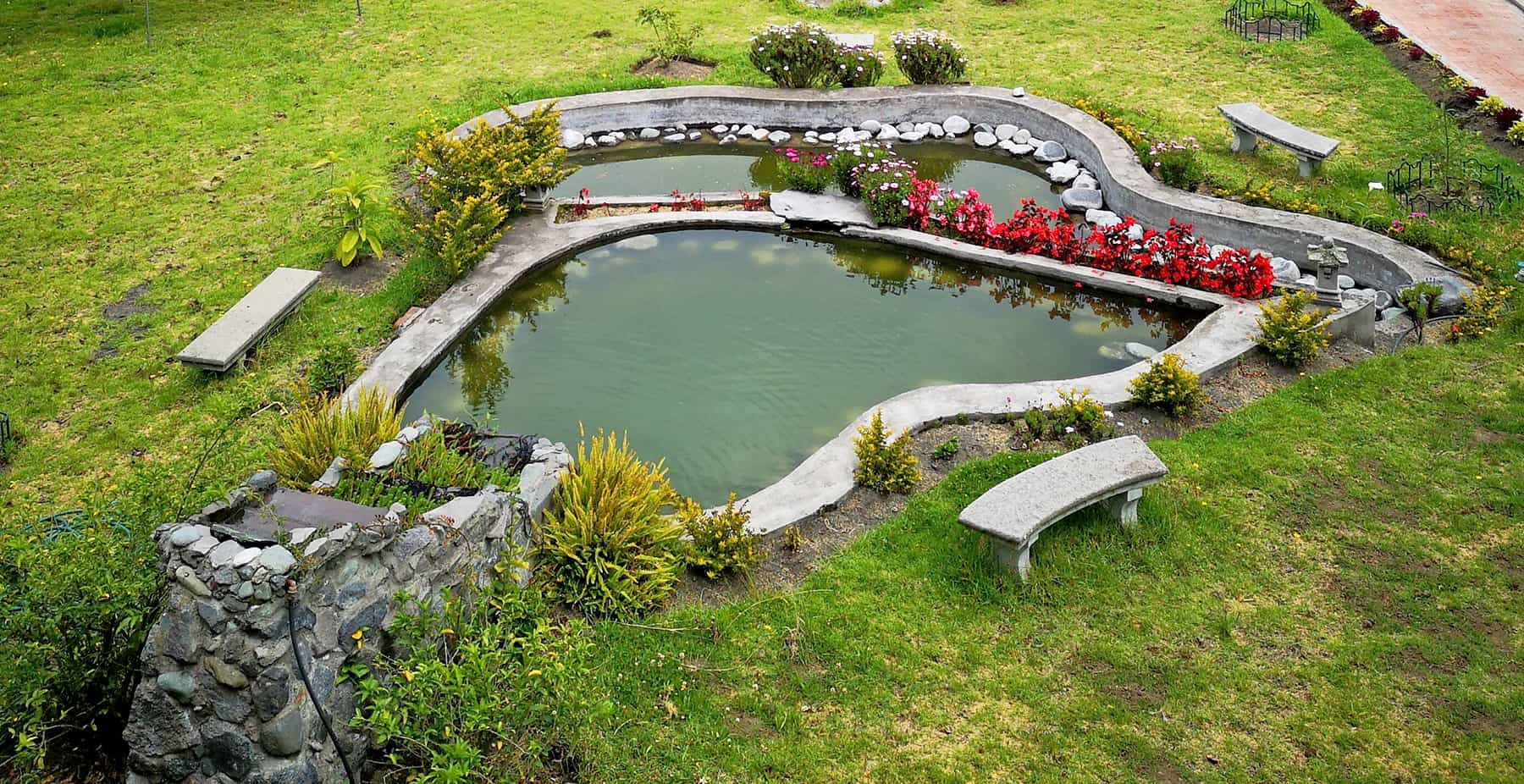
What Materials Will You Need
For Your Water Feature?
Bricks and mortar, rocks and concrete, clay or even a simple plastic liner are materials that can all be used to build a water feature. Various precast units may be used as fountains, and there are ready-made ponds available which can be sunk into the ground. Timber may be utilized for bridges, decking and jetties, and there is a wealth of other materials available to surface the surround of your pool. Various factors, including your building skills, budget, and the effect you want to achieve, will influence your choice.
Sodium Clay
Clay puddling is one of the oldest methods of creating an impermeable lining for ponds. Since few sites have suitable clay-rich soil naturally present, it is usually necessary to bring this in. To ensure the pond will be watertight, an impervious clay must be used. Alternatively, a montmorillonite or sodium clay like bentonite can be used.
Found in isolated pockets all over the world, bentonite is used in industry worldwide, from heavy construction and the foundry industry to wine making, where it is used as a clarification agent. This natural clay is processed and packaged in powder (or sometimes granular) form, specifically for the sealing of reservoirs and dams. It is not generally available from builders’ merchants; you will need to locate a specialist supplier. Amazon does have Bentonite clay available, see more. Alternatively, you may be able to buy ‘puddle clay’ from clay suppliers.
If minor cracks occur, or if the shell is punctured, the clay will move into the hole and repair it with no effort on your part.
This makes bentonite suitable for sealing fish ponds of all sizes, big and small. Another advantage is that it may be used with all types of soil, although if you have clay on site, you will need less bentonite than if it is sandy.
Sealing a pond in this way is reasonably straightforward and requires no special skills, but it is essential to follow the correct procedure (see The Best Pond Building Methods). If you do not, the pond may leak which, in turn, could result in the exposed clay drying out and eventually cracking.
One golden rule that should never be broken is to avoid using bentonite in wet weather, or even if rain threatens. Once the soil and bentonite have been compacted, it takes a couple of days for the water hydration process to take place, and for the material to swell fully.
Bentonite matting is another product which can be used to seal ponds. It is, however, a more expensive and less usual method. This material is not widely available in the majority of countries.
Flexible Liners
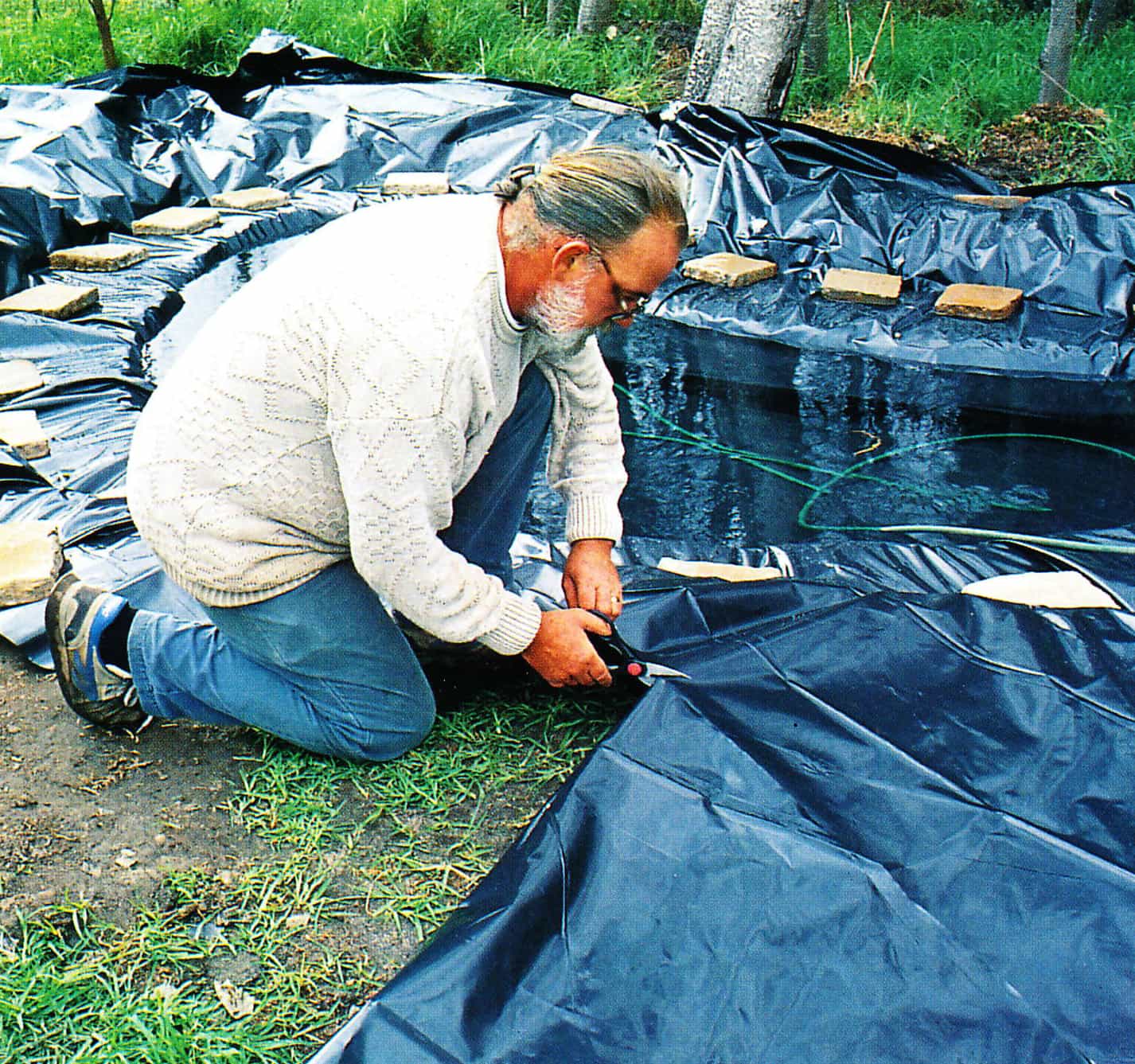
Various kinds of flexible liners are invaluable for the waterproofing of ponds and pools. Not only may they be used for just about any size or shape of pond, but also to establish a bog garden or even to line a cascade or waterfall.
Polyethylene is the most inexpensive type of flexible liner which, although widely available, is much maligned because it punctures relatively easily and deteriorates when exposed to the sun’s ultra-violet (UV). Commonly used for damp-proofing various parts of buildings, it is manufactured in various colors and different gauges. Black sheeting contains carbon which inhibits the effect of UV light and increases its lifespan, making this color the obvious choice for ponds. Fortunately, black pools also look more natural.
[ninja_tables id=”2121″]
Since it is an accepted fact that exposed polyethylene will become brittle and eventually degrade. it is best to lay pavers around the perimeter of the pond so that they overlap the water slightly, providing some protection from the sun. Also keep the pond topped up so the liner is constantly under water.
While it is quite possible to line a pond with relatively thin, 250 micron polyethylene, there is no doubt that 500 micron will last longer; and some experts even advise using the thicker plastic as a double layer.
Recycled polyethylene should be rigorously avoided as it does not have the strength of virgin plastic.
A cross-laminated, high density polyethylene, may be used with rubberized asphalt, which acts as an adhesive, to join (or even patch) this type of plastic. It is manufactured in sheets for waterproofing various parts of a building.
PVC or vinyl sheeting, commonly used to line swimming pools, is the second option. Normally considered more UV stable than polyethylene, it is most commonly manufactured in blue or black.
As it can be heat welded in the factory, PVC is suitable for quite large pools, and is sometimes packaged in kit form.
Here are a few more that will help you with your pond – 7ft X 10ft, 10ft X 13ft, 13ft X 20ft & 20ft X 20ft:
Like polyethylene. PVC may be punctured by sharp objects, and it is also affected by the sun. Although PVC itself does not stretch, the addition of plasticizers during the manufacturing process makes some PVC liners relatively elastic. This makes it easier to gradually smooth out crinkles and wrinkles as you fill the PVC-lined shell with water.
Laminated PVC which may be produced in tarpaulin grades, incorporates textile reinforcing which gives it strength.
Although it is commonly used as a pond liner in Britain & the USA, this application is not customary throughout the world.
Woven polypropylene, another type of plastic, is quite long-lasting and may be used to line ponds. More commonly used for erosion control, this matting material may be draped in the excavated hole and then coated with a rubberized bitumen sealer to make it completely waterproof. Unlike other liners, it cannot be used for ponds unless it is sealed.
Butyl rubber is undoubtedly the most expensive flexible liner, but one which the experts say is highly resistant to puncturing and degeneration as a result of UV rays. Normally black in color, it is said to have a life expectancy of at least 50 years.
Although it has various applications, butyl rubber has been used for half a century to line canals and reservoirs in some countries. If it is used for a pond, it should be at least 0.75mm (l4 in) thick.
EPDM, an ethylene propylene polymer, has taken the place of butyl in some countries. A cheaper rubber, it is also UV-resistant and thought to be long-lasting.
Rigid Liners
The range of preformed (pre-cast) ponds and rigid liners varies in different areas. The most common materials used for construction are fiberglass, fiber cement and various thermoplastic materials. Glass fiber reinforced cement ponds are a relatively new invention and not available world-wide; small features are molded into various shapes, while panels may be used together with a thermoplastic or butyl rubber liner.
Fibreglass (glass fiber reinforced polyester) may be molded to any configuration and used to create both formal and informal ponds. Made by bonding several layers of glass fiber with polyester resin, these pools may be made in virtually any color, although availability will depend entirely on the manufacturers in your area. They are invariably the most expensive option in this category of pond.
Fiber cement, like fiberglass, may be molded to virtually any shape. Although there is a wide selection of plant containers, there are few configurations of pond available, and the material itself is not common in all countries.
Made of a mixture of organic fibers, cement, and sometimes a small percentage of asbestos, fiber cement is lighter than precast concrete, but considerably heavier than fiberglass.
Thermoplastic shells are made from a variety of related materials including PVC and polypropylene. Demand probably regulates availability (they are common in Britain & the USA where numerous different designs are manufactured).
There is a good selection of liners to choose from see here: Preformed Pond Liners
Glass fiber reinforced cement (GRO is a relatively new product. Instead of using a resin with glass fiber to make a fiberglass shell, or cement with natural fibers to form fiber cement, glass fiber is combined with cement to make it rigid. While it is only available from specialist outlets and actual methods of manufacture may vary, this is an effective material, not only for natural preformed ponds, but for very realistic fake rocks as well. Molded to form panels, it can be used to support a vinyl-lining.
Concrete
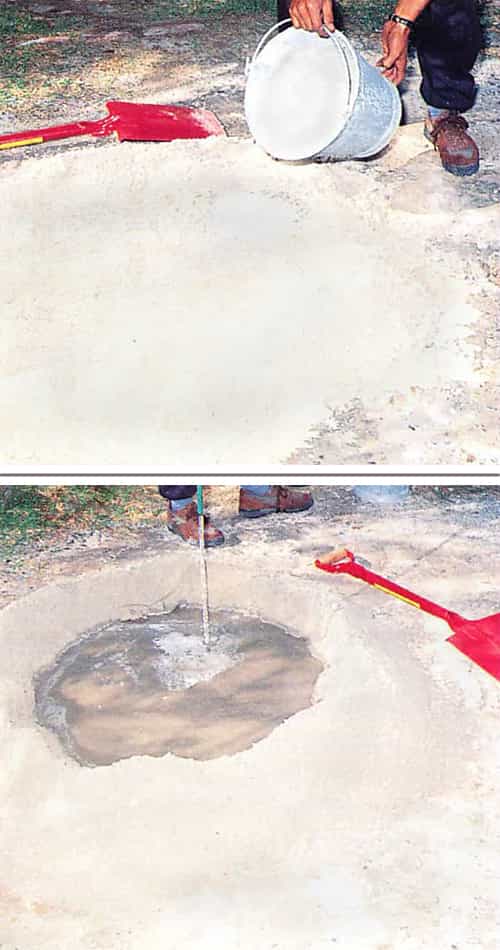
This multi-purpose material has a multitude of applications. It is used for foundations, to build some pool shells, as well as arched bridges and the footings for wooden decking set in the water. It is also useful for supporting paving around the edge of some ponds.
Concrete is made, quite simply, by mixing ordinary Portland cement, sand, and a coarse aggregate (crushed stone or coarse gravel) with water. Although it will be reasonably impermeable if a waterproofing compound is added to the mixture, concrete shells should also be rendered (covered with a coat of plaster) and coated with polyurethane or a bituminous water-proofing compound.
[ninja_tables id=”2193″]
While cement is commonly sold in 43 kg (94 lbs) bags or pockets, sand may be purchased in bulk or in 40 or 50 kg (88 or 110 lb) bags filled by builder’s merchants. The best quality sands are evenly graded and contain particles of various sizes, and a reasonably coarse or ‘sharp’ type (up to 4.75 mm or ¼ in) should preferably be used for concreting. Although the actual source of the sand is not a reliable guide to its quality, in general you will find that most natural pit or river sands are suitable for concrete work. Specially manufactured crusher sand, which is washed and graded, may also be used.
Like sand, aggregate, which is generally graded to a ‘single-size’, is sold bagged or by volume. Although quantities in this book are given for 19 mm (¾ in) stone, you may find it easier to work with a smaller 13.5 mm (½ in) aggregate if mixing by hand. If natural pebbles are available in your area, these may also be used, provided they are of a suitable size.
Packs of dry-mixed concrete are available at most major hardware outlets. Although more costly than buying the necessary materials individually, these may be more convenient for people tackling minor projects which call for small quantities of cement, sand and stone.
While sand and stone are easily stored outside under plastic or a tarpaulin, cement should rather be stacked indoors, preferably on a platform to prevent it getting wet and hardening. Discard lumpy cement as this indicates it has been exposed to moisture. If you can break the lumps up easily, or sieve them out, you can use it for minor garden projects; do not be tempted to use inferior quality cement to build a water feature.
The water used to mix concrete should be clean and fresh. A rule of thumb is that if you can drink it, you can use it.
Various grades of concrete are used for different projects. depending on their type and magnitude. While medium- and low-strength concrete is suitable elsewhere in the garden, watertight walls and pond foundations should be built from a high-strength 1:2:2 mixture of cement, sand and stone. Adjust this ratio to 1:2:1.5 if you are using the smaller-sized aggregate.
Bricks and Blocks
Made from burnt clay or precast concrete, bricks and blocks may be used for the walls of formal pools and, if you wish, for the surrounding paving. Both types come in a range of colors from charcoal to terracotta, and the laying procedure is the same, regardless of size.
If you are building walls, your immediate decision will be whether to render the brickwork, to use low-maintenance face bricks or reconstituted stone blocks and to leave the walls un-rendered.
Whatever you decide, you will need mortar, made with cement and sand, for bricklaying and possibly for jointing paving bricks or slabs. If you decide to render (plaster) your brickwork, cement and sand will be required for the render mixture.
Some ordinary building sands are suitable for mortar, but not the coarse sand that is normally used for concrete. In general, sand used to make mortar for bricklaying and rendering should be softer and finer than either the bedding sand laid under brick paving, or that used to make concrete. Maximum particle size should be no more than 2 or 3 mm (just a fraction of an inch). All sand should be free of clay, salt and vegetable matter. A good mortar mix for water features consists of cement and sand combined in the ratio 1:3.
Note that while it is usually considered good building practice to add hydrated builder’s lime to render to improve its plasticity and help prevent future cracking, this should be avoided when building ponds. Lime is toxic and can kill fish and other creatures. You can, if you wish, add a non-toxic plasticizer to the mixture to make it more cohesive. A waterproofing additive will make the render coat more impervious to water.
Although swimming pool builders frequently use marble plaster mixed 1:3 with white cement to give the shell a nice, smooth waterproof finish, this is an expensive and therefore infrequent option for fish ponds. Marble plaster is usually available in 25 kg (50 lb) bags.
If you decide not to coat the rendered pond with bitumen, it is best to fill and empty the feature several times before introducing plants or fish, to get rid of any traces of toxic lime (from the cement). Neutralizing chemicals may also be used.
Precast concrete materials
Various precast materials may be used when constructing water features.
Precast concrete products, which range from ordinary paving slabs to ornamental fountains, can be extremely useful when constructing water gardens and features.
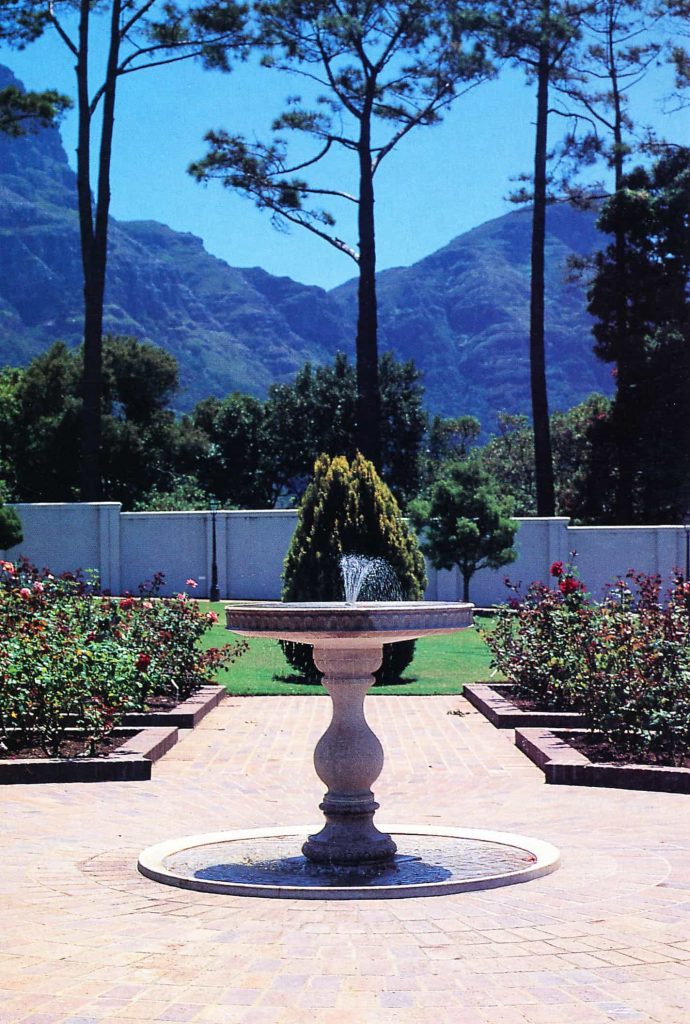
When paving around the perimeter of a pond or pool you can choose from concrete bricks, plain slabs and even interlocking units. Particularly popular are pavers, flagstones and setts (sometimes called cobbles), as well as imitation sleepers and fake log slices, all of which are made from reconstituted stone. Compressed or vibrated in molds, these simulated stone products have an attractive appearance and are especially well suited to the more natural type of water feature.
You Have to look at one of these for your garden, they are stunning.
[ninja_tables id=”2196″]
Precast fountains may be as plain or ornate as you wish, although those incorporating statuary are frequently used as a focal point in formal pools. Simple bird bath designs, manufactured from fiber cement as well as pre-cast concrete, may also be used as fountains. The majority of concreteworks will incorporate pipework in the mold to adapt them if necessary, while fiber cement is generally easy to drill into.
Fake fiberglass or GRC rocks are also useful when building a water feature. They are considerably lighter than the real thing, and may be used to camouflage the pond edge, to hide pumps, filters and so on, and even to construct rockeries for waterfalls.
Stone
A suitable material for use both in and around water features, stone comes in various guises. While boulders are the ideal choice for rockeries, natural and even reconstituted (or simulated) stone slabs are a common paving material around ponds and pools. A raised pond or bridge may be constructed from cut stone, and stepping stones created with reasonably flat rocks.
Stones can make a very effective edging around an informal pond, especially if you have some which stick out of the water, perhaps linking the pond to a pebble beach or bog garden.
When it comes to paving, an advantage of using man-made products is that they are reasonably regular in shape and size and therefore easier to lay. However, natural stone will blend with the environment more easily. Flagstones are relatively expensive and often difficult to find, but irregular pieces of cut stone or slate may be laid as crazy paving around ponds.
Another alternative is to use cobbles or setts (where available). Traditional setts were made from granite, and you can now buy concrete ‘cobbles’, which are flatter and more regular than water-worn stones taken from river beds. Of course, river stones are visually effective around a pond, but are not practical if you intend to use the area for sitting, as they create an irregular surface ill-suited to moveable furniture.
[ninja_tables id=”1966″]
For a Japanese-style feature, pebbles and crushed stone or gravel are the perfect complement for water. You may use these materials to create a beach alongside the pond, or even as a method of camouflaging the concrete or plastic liner in the water. Your local garden centre should stock bags of these materials, although stone and gravel may also be obtained from suppliers of aggregate intended for building work or paving.
If you do have access to local stone, either from your own property or from a nearby quarry, this is usually the best option for rockeries, as it will help to create a most authentic effect.
Tiles
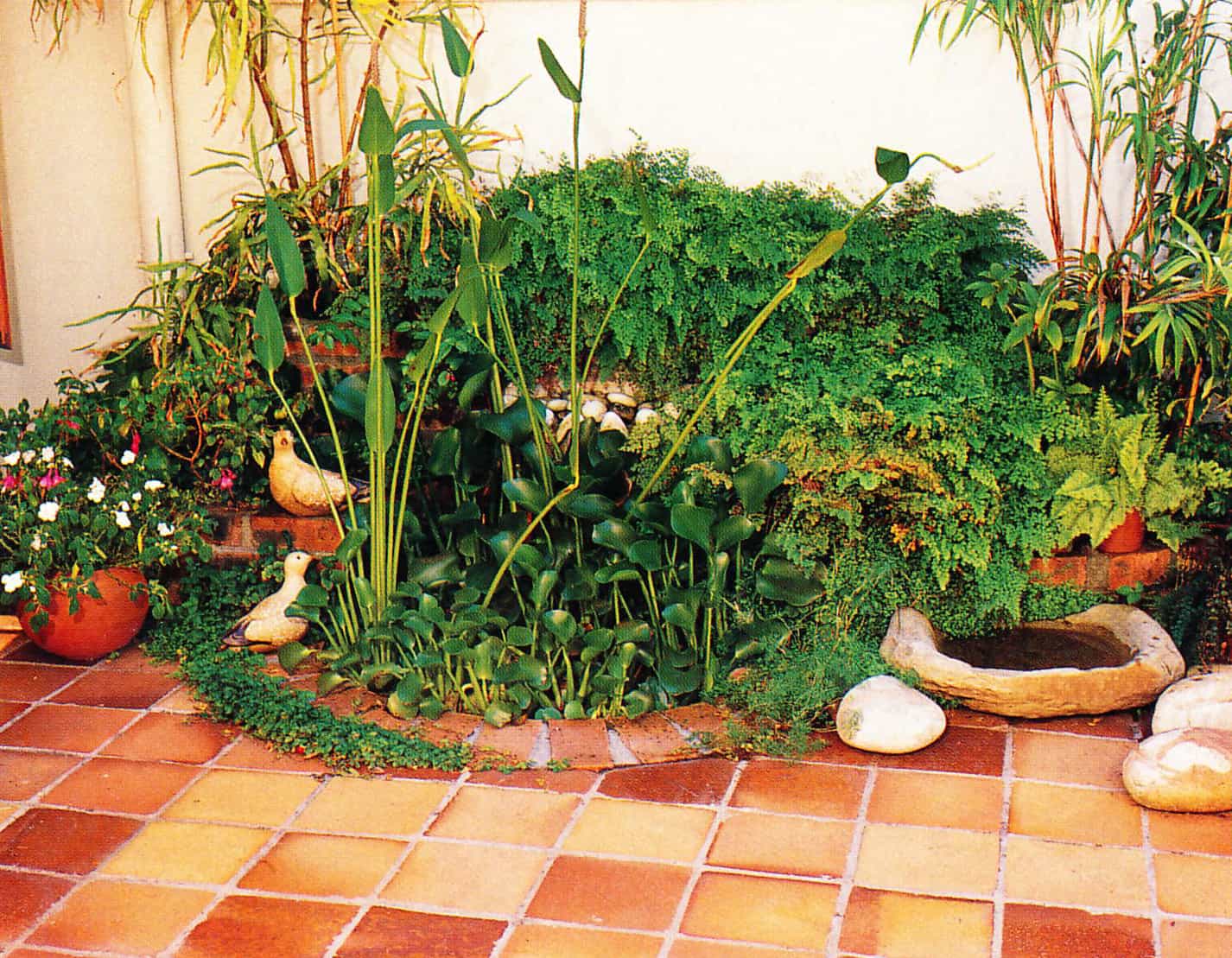
Suitable for patio surfaces and formal pool surrounds, tiles may be used around the edge of a pond or on top of stepping stones. Since glazed tiles become extremely slippery and therefore dangerous, use those that are intended for outdoors and make sure they have a matt finish. Terrazzo, terracotta and quarry tiles are all suitable. If yours is a formal pool and your budget allows, you could always consider punched (rather than polished) marble tiles which are non-slip.
Timber
Although not the most common material used to construct ponds and pools, timber should not be overlooked. Most hot tubs, which like spas are fitted with a filter, heater and jets, are constructed from timber (Californian redwood for instance), so there is no reason why this material should not be used for ponds.
Wooden wine barrels make attractive and watertight containers. Like hot tubs, they are made from timber which is resistant to rot and which swells when wet. Note that barrels which are not used for wine-making will usually have to be sealed to make them watertight.
[ninja_tables id=”2200″]
Hard wearing railway sleepers may be used to line the sides of a pool, or to build the entire structure. However, these will not be waterproof unless the interior surface of the pond is sealed with bitumen or fiberglass, or the excavation is first covered with a flexible liner.
Of course, timber is also a useful material for those special features which add the finishing touches to any water garden: bridges, adlacent decks, gazebos and jet- ties are all easily constructed from either poles or planks. Even though wood tends to get slippery in wet weather, it may be used as a flooring material for adjacent patios and as an edging for your pond.
Timber decks are particularly well suited to water gardens as the material blends well with the environment. While decking may be used successfully on both flat and sloping ground, to create terraces or simply to extend over a pond, a charming ploy is to allow water to flow under a deck to create the impression of a much larger feature than really exists.
Where part of the supporting structure of decking (or a jetty) is in the water, additional steps must be taken to ensure it is safe. You will have to treat wood that will remain submerged and piling may be required to anchor it securely. If necessary, consult an engineer who will design the foundations of the structure.
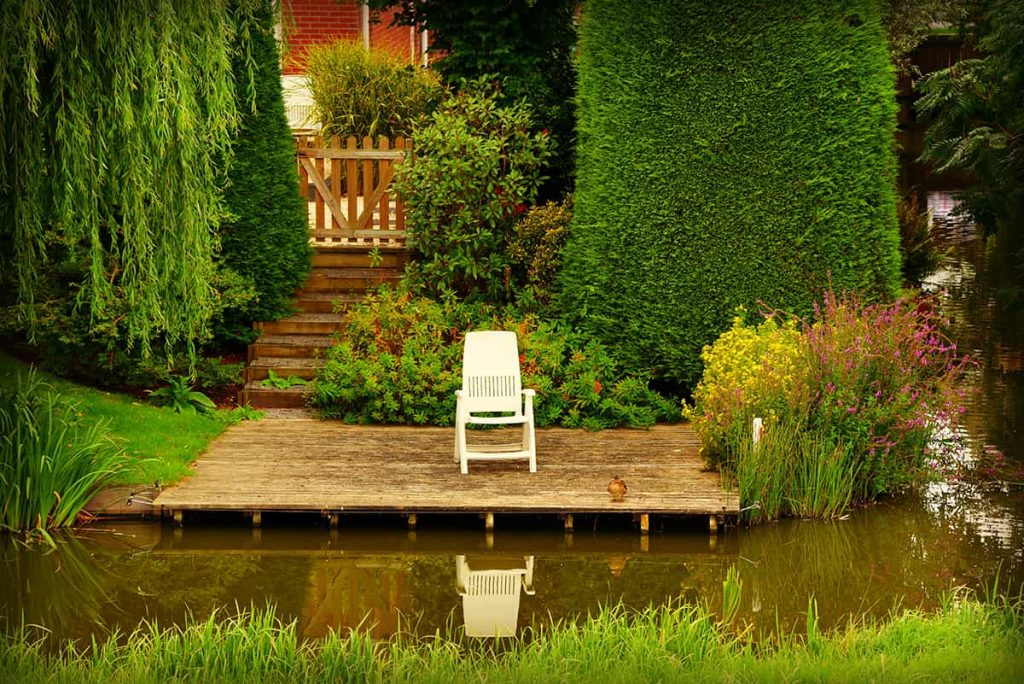
Wood can be bought as poles and split poles, or as sawn timber which may be rough-cut or planed all round (PAR). In addition, laminated beams, manufactured by gluing strips of wood together under pressure are available. These are usually expensive, but very stable and come in fairly long lengths.
While knots are unavoidable in various types of wood, it is best to avoid planks and boards with large knots as these can affect the strength of any structure.
Whatever you are building, it makes sense to use a wood that will last, and it is vital that the timber used for bridges and decks will not warp and split when it comes in contact with water. Although your choice will be limited to what is available in your area, you will find that hardwoods are generally more resistant than softwoods. One exception is Californian redwood, a softwood which is valued for its resistance to decay and infestation.
Some of the most popular species of hardwood include oak, which is attractive, strong and versatile; Philippine mahogany, another particularly durable wood; and, in hotter climates, balau, a fine-textured timber noted for its strength and durability and karri, a tough eucalypt which originated in Australia.
Nowadays, most sawn timber is treated with either organic or water-based preservatives, and is impregnated under extreme pressure in the sawmill. The actual chemicals used vary and some may be toxic to fish. However, a thick coating of hot tar or bitumen will protect the wood and seal in the poisons.
Although hardwood poles (which may be machined to size) are often dipped in creosote which is an oil distilled from coal tar, softwood poles like pine are more commonly treated under pressure with a water-based preservative like chromated copper arsenate (CCA). This may give the wood a slightly green tinge. While it is essential to buy timber that has been treated against infestation and rot, do investigate the poisons involved. Creosote is highly toxic and should be avoided.
Whatever wood you decide to use, store it indoors if at all possible. If not, it is advisable to stack it level at least 300 mm (1 ft) above the ground and to protect it with plastic or a tarpaulin to prevent it getting wet and warping or rotting before construction begins.
Metal
Although metal is often used to build public bridges, it is not common for ordinary gardens. In some situations, it can be used if combined with wooden slats. Apart from nuts, bolts, screws and other connecting mechanisms made from metal, reinforcing will also be required for some ponds and supporting wall structures. Although ordinary chicken wire (with its characteristic hexagonal mesh configuration) may sometimes be used, a more sturdy weld mesh is more frequently recommended. Sold in a roll, it can be cut to reinforce irregular shapes.
Since water is a constant factor, it makes sense to use metal that will not rust. Stainless steel, aluminum and galvanized or anodized metals are all suitable.
Waterproofing Materials
There are various ways to ensure water features will be impervious and it is advisable to familiarize yourself with the full range of waterproofing methods.
Both flexible and rigid liners are waterproof, while concrete and brickwork are porous. Rendering the internal surface will make it reasonably watertight, especially if a waterproofing additive is included in the mix. There are several types available and it is important to follow the manufacturer’s instructions to obtain good results.
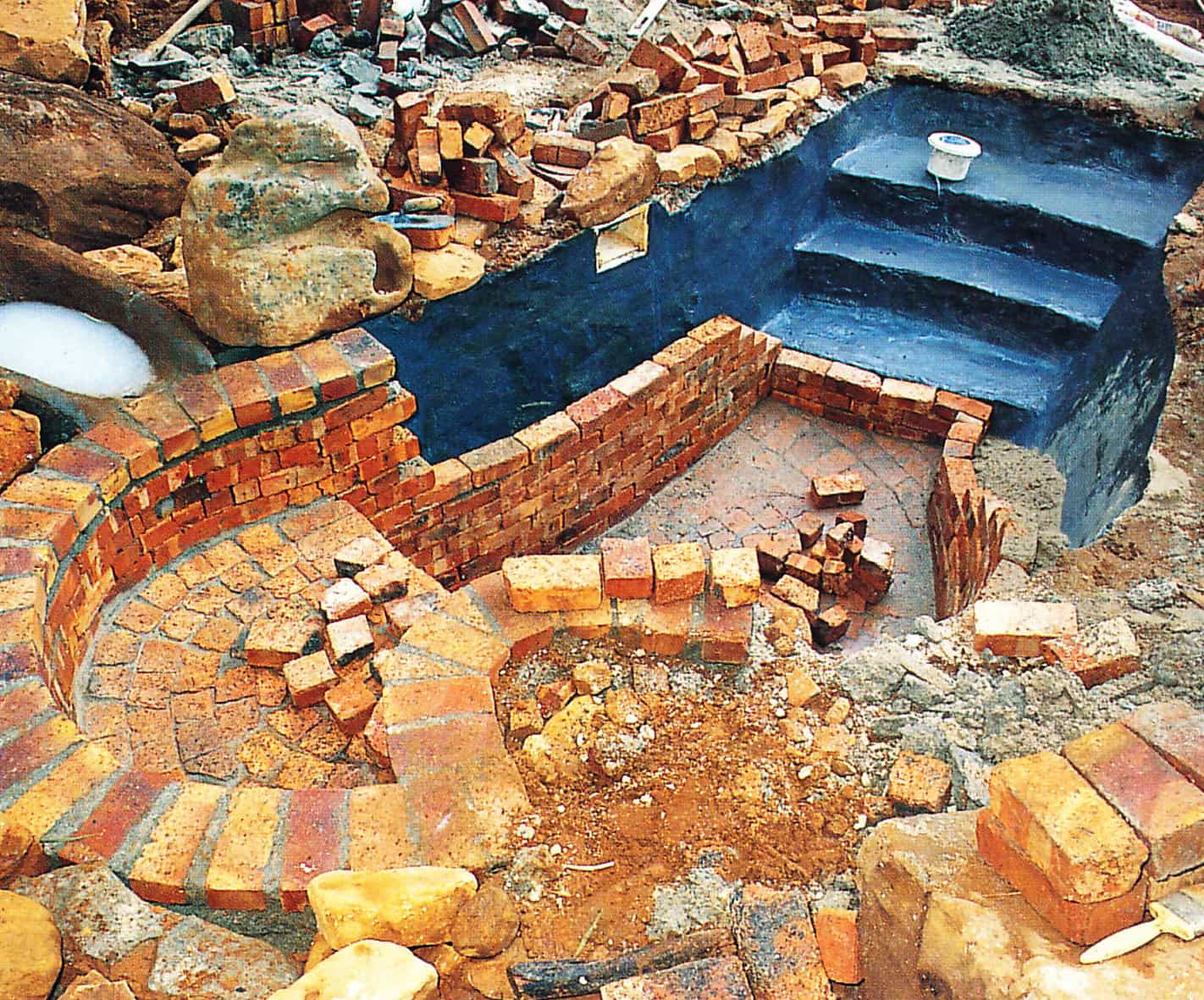
Although not a common choice for ponds, one of the finishes for modern-day swimming pools is marble plaster which gives the shell a smooth, waterproof skin. Made from white cement and granular marble dust (mixed with water in the ratio 1:3), marble plaster is more expensive than ordinary render and known to be adversely affected by certain environmental conditions. Like any plaster, it must be sealed or treated with a neutralizing chemical if you wish to keep fish.
Another possibility is to build a concrete or brick shell and to then make it watertight with a flexible liner or more costly fiberglass which is coated onto the surface in situ. The latter option, which may also be used to seal timber, is recommended where boulders and rocks are to be incorporated in the pond design.
Bitumen is one of the most common and least expensive sealants used by pond builders. Since it is black, it gives the pond a natural appearance. Choose a rubberized product which is water-based and non-toxic. Even if the pool has been rendered, this multi-purpose waterproofing compound is worth using as it will also prevent toxic lime from seeping into the water.
Moisture-curing polyurethane, available in different colors, including blue and black, may also be used to waterproof ponds. Products developed for use in tanks and dams containing drinking water and fish are tough, chemical resistant and non-toxic. You may need a specific primer, and may have to leave the pond to cure for a few days before filling it with water.
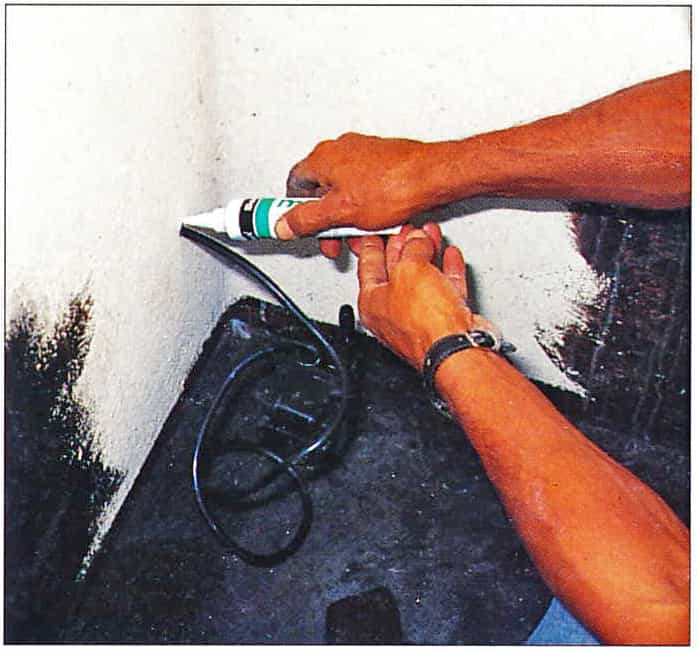
Various paints suitable for swimming pools may also be used. These may be either rubber-based, epoxy-based, vinyl- based, or acrylic.
Where holes have been drilled in walls to accommodate electric cables, use a suitable silicone sealer to prevent leaks.


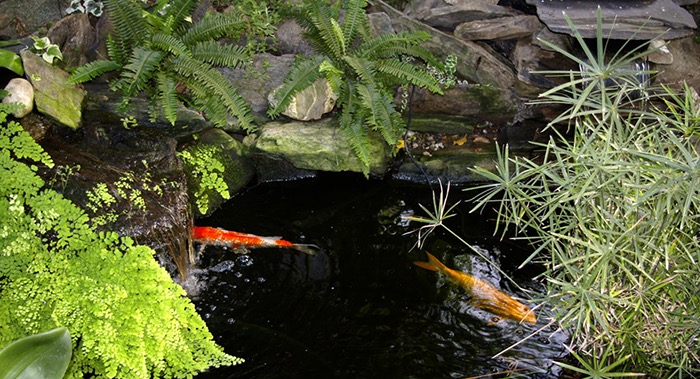




5 Comments